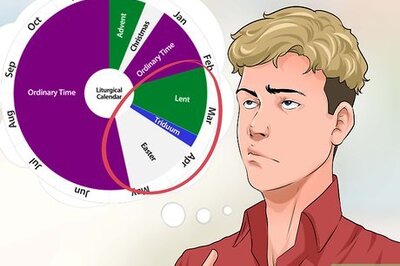
views
New Delhi: Google marks the 450th anniversary of Moscow's Saint Basil's Cathedral with a commemorative doodle on its home page. Known by various names, including the Cathedral of the Protection of Most Holy Theotokos on the Moat, Saint Basil the Blessed, Pokrovsky Cathedral, Russian Svyatoy Vasily Blazhenny and Pokrovsky Sobo, it was built by Tsar Ivan IV (the Terrible) to commemorate Russia's victories over Kazan and Astrakhan.
The construction of the Russian Orthodox church began in 1554 and was completed in 1561. Originally named the Holy Trinity Cathedral, over the centuries it became known as the place where St. Basil is buried. The church is located at Red Square, the centre of the city of Moscow.
Russia will celebrate the 450th anniversary of St. Basil's Cathedral by opening an exhibition dedicated to the so-called "holy fool" who gave his name to the soaring structure of bright-hued onion domes that is a quintessential image of Russia.
The eccentrically devout St. Basil wore no clothes even during the harsh Russian winters and was one of the very few Muscovites who dared to lambast tyrannical Czar Ivan the Terrible.
Ivan, whose gory purges claimed tens of thousands of lives, feared St. Basil as "a seer of people's hearts and minds," according to one chronicle. He personally carried St. Basil's coffin to a grave right outside the Kremlin. The cathedral, constructed to commemorate Ivan's victory over Mongol rulers, was built on the burial site.
The structure was designed by two Russian architects, Posnik and Barma. Some sources, though, attribute it to an Italian architect who was blinded after the completion so that he could never build anything as majestic again. The structure got its vivid colours, in which we can see it today, in several stages from the 1680s to 1840s.
The building was severely shelled during the 1917 Bolshevik takeover of the Kremlin and was patched up during the subsequent civil war and famine.
Early Communist leaders - who persecuted countless clerics of all faiths and destroyed tens of thousands of religious buildings - wanted St. Basil's dynamited as it blocked the way to military parades, and only the cathedral's conversion into a museum saved it.
A century earlier, Napoleon Bonaparte also ordered St. Basil's blown up during his army's hasty retreat from Moscow in 1812, but a heavy rain put down the burning fuses.
The design of its nine onion-shaped, multicoloured domes combine the traditions of Russian wooden architecture with Byzantine and Islamic influences into a unique structure.
Batalov said the restoration focused on recreating the way the building looked by the late 17th century, when the nine domes were united by a wraparound floor.
By that time, St. Basil's became a symbolic New Jerusalem and the center of Palm Sunday walks, when the Moscow Patriarch approached it sitting on a donkey to recreate Jesus' arrival in Jerusalem.
Google occasionally swaps its logo for an artistic doodle These Google doodles have gained immense popularity over the past few years and the Google doodle team has put out commemorative doodles on numerous events of international or national importance, ranging from news events, civic milestones, birthdays, death anniversaries and important dates in history.
Apart from the static image doodles Google also puts up animated and interactive doodles. The last interactive doodle was to celebrate the 96th birthday of the country and jazz guitarist, songwriter and inventor, Les Paul.
(With inputs from agencies)
















Comments
0 comment